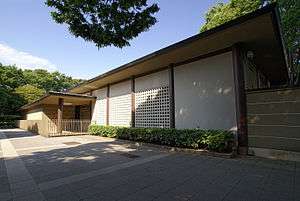Japan Art Academy
Japan Art Academy (日本芸術院, Nihon Geijutsu-in) is the highest ranking artistic organization in Japan. The Academy discusses art-related issues, advises the Minister of Education, Culture, Sports, Science and Technology on art-related issues, and promotes art (fine arts, music, literature, dance and drama though the annual Japan Art Academy Award (Nitten), the premier art exhibition in Japan. As a legal entity, it is an extraordinary organ of the Agency for Cultural Affairs. Its headquarters is in Ueno Park, Tokyo.

The Japan Art Academy should not be confused with the Japan Art Institute, which is a completely different organization.
History
The Japan Art Academy was founded in 1907 as the Fine Arts Reviewing Committee (Bijutsu Shinsa Inkai) of the Ministry of Education. It was intended to provide quality standards and a venue for art exhibitions in Meiji period Japan. The first exhibition, or Bunten, was held in 1907. It was renamed the Imperial Fine Arts Academy (Teikoku Bijutsu-in) in 1911 and headed by Mori Ōgai. The Bunten exhibition was correspondingly renamed the Teiten.
After a period where it fell into inactivity, it was reorganized into the Imperial Art Academy (帝国芸術院, Teikoku Geijutsuin) in 1937. In 1947, after World War II, the Imperial Art Academy became the Japan Art Academy, and its annual exhibition was correspondingly renamed the Japan Arts Exhibition (日本美術展覧会, nihon bijutsu tenrankai), which was abbreviated to Nitten (日展).
The government art exhibition Monten (Ministry of Education Art Exhibit) was founded in 1907 and amalgamated with the Teiten (Imperial Art Academy Exhibiion in 191. The Teiten was renames Shinmonten and has been known as Nitten since 1946.[1]
In 1958, there was further re-organization whereby the Japan Fine Arts Academy became a solely academic and consultative non-profit organization, and the organization of the Nitten annual exhibition was handled by a separate private company, the Nitten Corporation.
Membership
The Japan Art Academy is under the Ministry of Education, Culture, Sports, Science and Technology. It consists of a maximum of 120 members, who are appointed for life.
Membership is divided into the following categories
A. Fine Arts
- Nihonga
- Yōga
- Sculpture
- Crafts
- Calligraphy
- Architecture
B. Culture
- Novels, prose literature
- Poetry
- Essays, translation
C. Music & Drama
- Western music
- Traditional music
- Drama
- Dance
List of leaders
- Mori Ōgai (1919–1922)
- Kuroda Seiki (1922–1924)
- Ryōjirō Fukuhara (福原鐐二郎) (1924–1931)
- Naohiko Masaki (正木直彦) (1931–1935)
- Tōru Shimizu (清水澄) (1937–1947)
- Seiichirō Takahashi (高橋誠一郎) (1948–1979)
- Jirō Arimitsu (有光次郎) (1979–1990)
- Tadashi Inumaru (犬丸直) (1990–2004)
- Shumon Miura (三浦朱門) (2004–2014)
- Kuroi Senji (黒井千次) (2014–present)
Nitten
The Japan Fine Arts Exhibition (日展, Nitten (Nihon bijutsu tenrankai)) claims to be the largest combined art exhibition of its kind in the world, attracting a great number of fans and art critics. The exhibition consists five art categories: Nihonga and Western Style Painting, Sculpture, Crafts and Calligraphy. During each exhibition, works of the great masters are shown alongside works of the new but talented artists.
The Japan Fine Arts Exhibition decided not to award any of the top prizes in any of the 5 sections for 2013, following the revelation of fraudulent judging in the calligraphy section of the fiscal 2009 show. It was the first time since 1958, when the organization became a nonprofit corporation, that none of the prizes were awarded.[2]
References
- Brandt, Kim. Kingdom of Beauty: Mingei and the Politics of Folk Art in Imperial Japan. p. 252.
- "Nitten cancels top prizes over fraudulent judging". Yomiuri Shimbun. Retrieved November 3, 2013.
External links
- Home page (in English)
- Home page of the Nitten